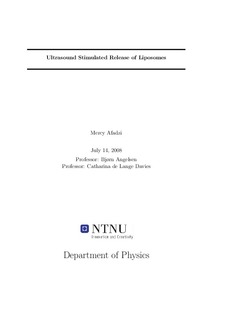| dc.description.abstract | A prerequisite for successful cancer therapy (drug delivery) is that the cytotoxic agents reach all cancer cells and inactivates them and this requires triggerable release of liposomes in order to delivery a high local dose to the cancer cells. The overall aim of this project is to improve the delivery of liposomal drug by combining ultrasound and liposomal drug delivery: Thus, to investigate the effect of ultrasound on release of liposomal drug at various frequencies, intensities, exposure time and medium and also to design an experimental setup to investigate this task. In vitro studies using liposomal calcein as a model for the therapeutic molecules was carried out using four ultrasound transducers (200kHz, 500kHz, 1MHz and 2MHz) at different intensities, exposure time and medium (PBS and HEPES) and release was studied by measuring the fluorescent intensity with a spectrophotometer. Drug release was found to be dependent on frequency, intensity, exposure time and the medium. The optimal frequency was found to be 500 kHz at an acoustic intensity of 0:038mW=cm2 and mechanical index of 0.5 which gave 15% average release. Maximum release was obtained at the highest exposure time (600s) for all frequencies and PBS gave higher release than HEPES. The acoustic intensities and mechanical indexes obtained with these transducers suggests the mechanism of release to be stable cavitation.
This research establishes the design of experimental setup and protocols which includes design of ultrasound probes and construction of sample holders used during ultrasound exposure for control release experiment. It confirms the dependency of frequency and acoustic pressure, intensity and exposure time in ultrasonically-triggered drug delivery from liposomes, and finally proposes stable cavitation as the mechanism for the release using the value of the mechanical index as an indicator. This opens the door for further investigations to know the mechanism that is associated with drug release in this field of study. | nb_NO |
